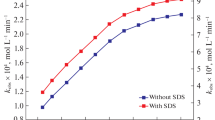Abstract
A spectrophotometric routine was used to study the cationic surfactant-based catalysis on the oxidation of glutamic acid (GTA) by bis-(2-pyridinealdoximato)dioxomolybdate(IV) complex at 302 K and an absorption maxima of 560 nm. It follows an acid independent oxidative pathway that is medium-sensitive. Charge density from the reaction species contributes to the redox acceleration, resulting in an upturned primary salt effect with an enhanced reaction rate. Modifying reaction medium with ethanol led to a rise in the oxidation time as the charge catalysis was unsupported by a drop in the system permittivity. Likewise, the inclusion of cetyltrimethylammonium bromide in the system increased the oxidation rate of the GTA due to the high impact of hydrophobic and ion interaction between the micelle and substrates. First order reaction kinetics was observed in the redox partners’ concentration. A 1:1 (complex:GTA) stoichiometry was obtained with the involvement of aldehyde succinic radical, resulting in succinic acid and a Mo2+ deactivated complex. The occurrence of counterion catalysis is pronounced in the reaction system. The standard enthalpy (24.98 \(\pm\) 0.03 kJ mol−1) and Gibbs energy (79.32 \(\pm\) 0.05 kJ mol−1) suggest that the process is energy demanding. The investigation of surfactant-based catalysis in the reaction system was quantitatively ascertained from the Piszkiewicz model of the complex interaction sequence.
Graphical Abstract












Similar content being viewed by others
Data Availability
The data available on request from the authors.
Abbreviations
- CTAB:
-
Cetyltrimethylammonium bromide
- NBP:
-
N-bromophthalimide
- BAB:
-
N-bromobenzenesulphonamide
- GTA:
-
Glutamic acid
- SC:
-
Conductivity
- TX-100:
-
Triton X-100
- FTIR:
-
Fourier transform infrared spectrophotometer
- BDH:
-
British drug house
- D:
-
Medium permittivity
- µ:
-
Salt concentration
- kobd :
-
Observed rate constant
- k2 :
-
Second order rate constant
- CMC:
-
Critical micellisation concentration
- A/Abs:
-
Absorbance
- T:
-
Temperature
- K:
-
Equilibrium constant
References
Felizola SJ, Nakamura Y, Satoh Y et al (2014) Mol Cell Endocrinol 382:170–177
Alhaji NMI, Lawrence SSM (2011) E-J Chem 8:1472–1477
Puttaswamy Vaz N (2001) Proc Indian Acad Sci 113:325–332
Gowda BT, Shetty M (2004) J Phys Org Chem 17:848–864
Sar P, Saha B (2020) Adv Colloid Interface Sci 284:1–14
Sen PK, Gani N, Midya JK et al (2012) Int J Chem Kinet 44:482–493
Williams RJP, da Silva JJRF (2002) Biochem Biophys Res Commun 292:293–299
Mendel RR (2005) J Royal Soc Chem Dalton Transit 2005:3404–3409
Konidari KF, Raptopoulou CP, Psycharis V et al (2010) Bioinorg Chem Appl 2010:159656
Onu AD, Iyun JF, Idris SO (2015) Open J Inorg Chem 5:75–82
Osunkwo CR, Nkole IU, Onu AD et al (2018) Int J Adv Chem 6:121–126
Nkole IU, Abdulsalam S, Ibrahim I et al (2021) Chem Afr 4:525–533
Jeffery GH, Bassett J, Mendham J et al (1989) Vogel, 5th edn. Wiley, New York, pp 180–500
Sanjana M, Patnaik AK, Badamali SK et al (2012) J Chem 2013:1–7
Jayapriya G, Shoba FG (2014) Asian J Plant Sci Res 4:20–24
Arthur DE, Nkole IU, Osunkwo CR (2020) Chem Afr 4:63–69
Nkole IU, Osunkwo CR, Onu AD et al (2018) Int J Adv Chem 6:102–107
Osunkwo CR, Nkole IU, Onu AD et al (2018) Nig Res J Chem Sci 5:82–97
Abdulsalam S, Idirs SO, Shallangwa GA et al (2020) Heliyon 6:e04621
Ibrahim I, Idris SO, Abdulkadir I et al (2019) Transit Met Chem 44:269–273
Dennis CR, Van Zyl GJ, Fourie E et al (2021) Reac Kinet Mech Catal 132:599–615
Ogunlusi GO, Oyetunji OA, Owoyomi O et al (2016) J Dispers Sci Technol 38:1129–1134
Nkole IU, Idris SO (2021) Chem Afr 4:731–740
Nkole IU, Idris SO, Onu AD (2021) Inorg Chem Commun 133:108930
Chakraborty M, Mandal PC, Mukhopadhyay S (2013) Inorg Chimica Acta 398:77–82
Shanmugaprabha T, Selvakumar K, Rajasekaran K et al (2016) Transit Metal Chem 41:177–185
Alam MS, Ragupathy R, Mandal AB (2016) J Dispers Sci Technol 37:1–22
Laguta AN, Eltsov SV, Mchedlov-Petrossyan NO (2018) Int J Chem Kinet 51:83–94
Laguta AN, Eltsov SV, Mchedlov-Petrossyan NO (2019) J Mol Liq 277:70–77
Jiang B, Du J, Cheng S et al (2003) J Dispers Sci Technol 24:755–760
Jalali F, Gerandaneh A (2011) J Dispers Sci Technol 32:659–666
Sood AK, Sharma S (2016) Phys Chem Liq 2016:1–15
Baloch M, Hameed G, Bano A (2002) J Chem Soc Pakistan 24:77–86
Acknowledgements
Department of Chemistry, Ahmadu Bello University Zaria
Funding
The research did not receive grant from any organization or institution.
Author information
Authors and Affiliations
Contributions
IUN, SOI, and IA: conceived and design the study. ADO, IUN, and SOI: collected and analyzed the data. IUN, SOI, IA, and ADO: drafted the manuscript, revised the manuscript critically for important intellectual content. All authors read and approved the final manuscript.
Corresponding author
Ethics declarations
Conflict of interest
The authors declare no conflicts of interest.
Ethical Approval
Not applicable.
Consent to Participate
Not applicable.
Consent for Publication
Not applicable.
Additional information
Publisher's Note
Springer Nature remains neutral with regard to jurisdictional claims in published maps and institutional affiliations.
Supplementary Information
Below is the link to the electronic supplementary material.
Rights and permissions
Springer Nature or its licensor (e.g. a society or other partner) holds exclusive rights to this article under a publishing agreement with the author(s) or other rightsholder(s); author self-archiving of the accepted manuscript version of this article is solely governed by the terms of such publishing agreement and applicable law.
About this article
Cite this article
Nkole, I.U., Idris, S.O., Abdulkadir, I. et al. Cationic Surfactant-Based Catalysis on the Oxidation of Glutamic Acid by Bis-(2-pyridinealdoximato)dioxomolydate(IV) Complex. Catal Lett 153, 3581–3590 (2023). https://doi.org/10.1007/s10562-022-04187-w
Received:
Accepted:
Published:
Issue Date:
DOI: https://doi.org/10.1007/s10562-022-04187-w




